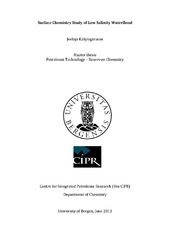Surface Chemistry Study of Low Salinity Waterflood
Master thesis
Permanent lenke
https://hdl.handle.net/1956/7060Utgivelsesdato
2013-06-03Metadata
Vis full innførselSamlinger
Sammendrag
There is increasing evidence that injecting low salinity brines has a significant impact on the amount of oil recovered, but the exact mechanism by which this occurs is an unsettled issue, and is supposed to be a cause of the complex interactions occurring between the phases in-situ. In this thesis, surface chemistry of low salinity brines has been investigated. Fluid/solid and fluid/fluid interactions for two North Sea crude oils in the presence of high salinity brine and a set of dilutions of this have been studied and compared. Fluid/solid interactions were investigated through wettability studies. Impact of ionic strength, pH and zeta potential on this interaction was measured through contact angle measurements and adhesion test. Microscopic glass slides made of quartz were used to simulate water-wet sandstone. Fluid/fluid interactions were studied by interfacial tension measurements between crude oils and brines using the drop-volume method. Further, one of the crudes was mixed with organic liquids to study the impact of these chemicals on crude oil properties. The main findings from this study showed that crude oil and brine composition to be of major importance for the observed trends. One of the crudes was more sensitive to reduction in brine salinity than the other, and showed more water-wet behaviour with reduction in salinity. Adhesion mapping and zeta potential measurement showed that a combination of low salinity and low pH brines will make it easier to alter the wettability to more oil-wet. The most favourable interfacial tension was obtained with high salinity brine and interfacial activity dominated by ionized acidic species. The combined impact of the organic liquids did not change the crude oil property significantly.
